Introduction
Pentax SMC DA 15mm F4 ED AL Limited review
Pentax SMC DA 21mm F3.2 AL Limited review
Pentax SMC DA 70mm F2.4 Limited review
Pentax SMC DA 40mm F2.8 Limited review
Pentax SMC DA 35mm F2.8 Macro Limited review
This limited-edition Pentax fixed lens that came out in 2009 is a pancake lens with a focal equivalent of 24mm on a full-frame camera… so it isn’t a very wide-angle lens. Compact, it measures 39.5mm long and weighs in at 212g. It will certainly adapt very well to the upcoming Pentax K01 that we hope to be able to test quickly.
The optical formula of this 15mm lens integrates a low-dispersion (ED) glass element to limit chromatic aberrations, and an aspherical element (AL) to correct distortion.
Note that this limited edition has benefited from particular attention to quality and finish. Although it’s difficult to verify the ways in which its manufacture is different, the number of lenses produced per day has been deliberately limited to better control per-unit quality.
Measurements
Pentax SMC DA 15mm F4 ED AL Limited mounted on a Pentax K5
The strong points of the Pentax smc DA 15mm F4 ED AL Limited:
- Very well-controlled distortion for this type of lens.
- At full aperture, vignetting darkens only the corners.
The questionable points of the Pentax SMC DA 15mm F4 ED AL Limited:
- Not a bright lens.
- Despite the ED glass element, chromatic aberrations are visible.
- The resolution is rather disappointing.
Comparison
Pentax SMC DA 15mm F4 ED AL Limited mounted on a Pentax K5 vs Nikon AF Nikkor 20mm f/2.8D mounted on a Nikon D7000
The Pentax 15mm achieves a DxOMark score that is four points lower than that of the Nikon 20mm. What makes this comparison even more pertinent is that both cameras use the same Sony sensor.
The advantages of the Pentax SMC DA 15mm F4 ED AL Limited:
- Better correction of distortion.
- Better correction of chromatic aberrations.
The advantages of the Nikon AF Nikkor 20mm f/2.8D:
- Better sharpness.
- A brighter lens.
- Better correction of vignetting.
For more information, see the complete DxOMark results for the Nikon AF Nikkor 20mm f/2.8D.
Pentax SMC DA 15mm F4 ED AL Limited vs Pentax SMC PENTAX DA 14mm F2.8
Pentax offers two choices at nearly the same price, this 15mm f/4 lens and a 14mm f/2.8 lens. Photographers who prefer compactness will want to seriously consider the 15mm f/4, even though the 14mm f/2.8 is slightly brighter.
In terms of image quality, the two lenses are fairly close. Although the 15mm f/4 better controls both distortion and chromatic aberrations, its overall results are hampered by its weak resolution and its serious lack of uniformity in the field.
For more information, see the complete DxOMark results for the Pentax SMC PENTAX DA 14mm F2.8.
Conclusion
The SMC DA 15mm F4 ED AL Limited is an interesting lens that we wish were brighter. While its control of distortion is remarkable, its resolution is a bit weak, which is a shame, since it means that photographers will not be able to take full advantage of the Pentax K5’s 16Mpix sensor. In short, this lens could be improved to better appeal to those looking for a compact wide-angle.
Pentax was one of the first manufacturers to offer a coherent line of pancakes that is, fixed focal-length lenses at reduced size. Since the explosion of hybrid cameras, compactness has become a real selling point, and so pancake lenses are once again in style… giving us the chance to see what Pentax has to offer now that we’re several years further down the road.
To continue with our analysis of Pentax pancake lenses, and to folllow our analysis of the Pentax smc DA 15mm F4 ED AL Limited, we present here the Pentax smc 21mm F3.2 ED AL Limited. As with all lenses in the “limited” series, this lens has a high-end finish: aluminium, 8 glass element in 5 groups, and of course the classic characteristics of all pancake lenses:
- Very compact — only 25mm long.
- Very light — only 140g.
Its Full-Frame focal equivalent is 32mm, which makes it a practical choice for landscape and ordinary street photography. Its optical formula includes an aspherical element in an effort to limit chromatic aberrations.
Measurements
Pentax smc DA 21mm F3.2 AL Limited mounted on a Pentax K5
Regrettably, the DxOMark score for this lens is a disappointing 11 points.
The good points of the Pentax smc DA 21mm F3.2 ED AL Limited:
- Compact.
- Light-weight.
Points that could be improved:
- Strong vignetting in the corners.
- Too-apparent chromatic aberrations.
- Rather weak resolution and not particularly uniform over the field.
Comparisons
Pentax smc DA 15mm F4 ED AL Limited vs Pentax smc DA 21mm F3.2 AL Limited
Just a small, quick comparison between the 21mm f/3.2 and the 15 mm f/4 previously analyzed: the 21mm stays ahead of the 15mm in nearly every respect except for chromatic aberrations.
Those who don’t really need a very wide-angle lens shouldn’t hesitate to choose the 21mm.
Pentax smc DA 21mm F3.2 AL Limited vs Olympus M.ZUIKO DIGITAL 17mm f2.8
With Full-Frame focal equivalents of 32mm for the Pentax and 34 mm for the Olympus, these 2 lenses have quite similar results. Still, we prefer the Pentax model, given that the distortion is better controlled. Otherwise, the qualities and defects of these two lenses are very similar.
Pentax smc DA 21mm F3.2 AL Limited mounted on a Pentax K5 vs Carl Zeiss Distagon T 21mm f/2.8 ZF2 Nikon mounted on a Nikon D7000
The advantages of the Pentax smc DA 21mm F3.2 AL Limited:
- The most compact lens.
- The lightest lens.
- The least expensive lens.
The advantages of the Carl Zeiss Distagon T 21mm f/2.8 ZF2 Nikon:
- Better resolution.
- Brighter (around +0.17EV).
- Better vignetting behavior.
- Better correction of chromatic aberrations.
Here we see the limits that one can encounter with pancake lenses. Because the emphasis is on compactness, sometimes certain optical characteristics are not as well-controlled — such as, for example, the fact that there are many chromatic aberrations and the resolution is weaker at larger apertures.
Conclusion
The Pentax smc DA 21mm F3.2 AL Limited is rather disappointing in terms of its correction of chromatic aberrations, though it is still a good choice for reportage photography. As this lens is getting a bit long in the tooth, it would be nice to see a redesign of this equivalent of a 35mm lens — a focal length that is very popular with photographers.
The equivalent of a 105mm on a full-frame, very compact (only 26mm long) and very light (only 130g): we go on our first round of reviews of Pentax pancake lenses with the Pentax smc DA 70mm F2.4 Limited (with other reviews to follow later on down the road).
Here Pentax offers a lens with a relatively adequate aperture for taking portraits. We would have liked a slightly larger aperture so as to have a better depth of field for portrait-taking (as a reminder, the greater the aperture and the more shallow the depth of field is what enables photographers to differentiate the subject of their composition from the blur of the background).
This lens has the same high-quality construction as the other 2 pancakes previously analyzed (the Pentax smc DA 21mm F3.2 AL Limited and the Pentax smc DA 15mm F4 ED AL Limited). But we must still ask — is it possible to create such a compact lens without sacrificing image quality?
Measurements
Pentax smc DA 70mm F2.4 Limited mounted on a Pentax K5
The good points of the Pentax smc DA 70mm F2.4 Limited:
- More than correct sharpness.
- A bright lens.
- Well-controlled distortion.
- Good control of chromatic aberrations.
- Compact.
- Light-weight.
The single questionable point about the Pentax smc DA 70mm F2.4 Limited:
- Vignetting a bit too apparent.
Comparison
Pentax smc DA 70mm F2.4 Limited mounted on a Pentax K5 vs Sigma 70mm F2.8 EX DG Macro Nikon mounted on a Nikon D7000
The advantages of the Pentax smc DA 70mm F2.4 Limited:
- The brightest (around +0.29EV).
- The fewest chromatic aberrations.
- The most compact.
- The lightest.
The advantages of the Sigma 70mm F2.8 EX DG Macro Nikon:
- Better resolution.
- Zero distortion.
- Better vignetting behavior.
Conclusion
The Pentax smc DA 70mm F2.4 Limited is a beautiful lens — one of the brightest in the Pentax Limited series.
Despite having been unconvinced about the image quality of the first lenses we analyzed in this series, we must say that this 70mm pancake lens turns out to be very interesting for anyone looking for an unobtrusive and light-weight lens. We hope to return to this lens again by comparing it to the Pentax smc FA 77mm F1.8 Limited, which we expect to analyze in the near future.
The Pentax SMC DA 40mm F2.8 Limited, which came out in 2004, is still made by the Nippone company. Ultra-compact and light-weight — 15mm for 90g, this is a true pancake. Thus we find in a very confined space five glass elements and a 9-bladed diaphragm for better rendering of blurry backgrounds.
Note that this is not Pentax’s first try at producing pancake lenses: it’s been doing so since 1976 for its analog cameras. While we wait for the results of its new version, the Pentax smc DA 40mm f2.8 XS, let’s take a look at the optical performance results of the first 40mm pancake designed for Pentax digital cameras.
This 40mm is the full-field equivalent of a 60mm, making it an “all-terrain” general-purpose lens. And as with all lenses in the “limited” category, this Pentax 40mm was carefully built.
Measurements
Pentax smc DA 40mm F2.8 Limited mounted on a Pentax K5
A DxOMark score of 11 is not very good. (The score was derived at f/4 because the resolution over the field drops significantly at f/2.8.) Its best compromise between light and resolution is f/4.
The good points of the Pentax smc DA 40mm F2.8 Limited:
- Decent resolution starting at f/5.6.
- Well-corrected distortion.
- Vignetting “correct” for this kind of lens.
- Invisible or barely-visible chromatic aberrations.
- Remarkable compactness.
- Very light-weight.
The “debatable” points of the Pentax smc DA 40mm F2.8 Limited:
- The resolution at f/4 and f/2.8 is quite disappointing both over the field and in the center.
- Lack of brightness.
Comparison
Pentax smc DA 40mm F2.8 Limited mounted on a Pentax K5 vs Nikon AF Nikkor 35mm f/2D mounted on a Nikon D7000
The two lenses have close scores for nearly all the metrics, but with a DxOMark score of 16, the Nikon AF Nikkor 35mm f/2D mounted on a Nikon D7000 is 5 points ahead of the Pentax smc DA 40mm F2.8 Limited mounted on a Pentax K5. The difference in scores is largely explained by the resolution at wide aperture. Whereas the Nikon 35mm f/2.0 maintains decent resolution at f/2.8, the Pentax drops like a stone. The comparison is especially relevant, given that both cameras make use of the same Sony sensor.
The advantages of the Pentax smc DA 40mm F2.8 Limited:
- More compact.
- Lighter.
The advantages of the Nikon AF Nikkor 35mm f/2D:
- Brighter (around 1.12EV).
- Slightly less vignetting.
See also Nikon AF-D lens reviews
Conclusion
The SMC DA 40mm F2.8 Limited is an extremely light-weight and compact pancake lens that masters distortion and chromatic aberrations well. Nevertheless, its compactness comes at the price of only so-so brightness and a resolution at wide aperture that really could stand some real improvement.
We are very much looking forward having the chance to compare it with the new Pentax smc DA 40mm f2.8 XS, whose measurements on a Pentax K 01 will be available in the not-too-distant future. In the meantime, we can at least compare the specs for both these 40mm lenses:
Pentax smc DA 40mm f2.8 XS vs Pentax SMC DA 40mm F2.8 Limited
We see that Pentax certainly managed the feat of not only of reducing the weight of its 40 mm lens by more than 40g (the weight is nearly divisible by 2), but also in significantly reducing its size (9.14mm for the XS vs. 15mm for the limited). We hope that our upcoming tests will reveal that Pentax will have succeeded in improving its resolution at wide apertures.


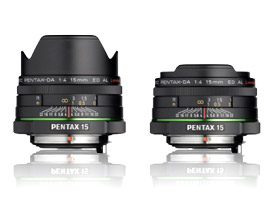
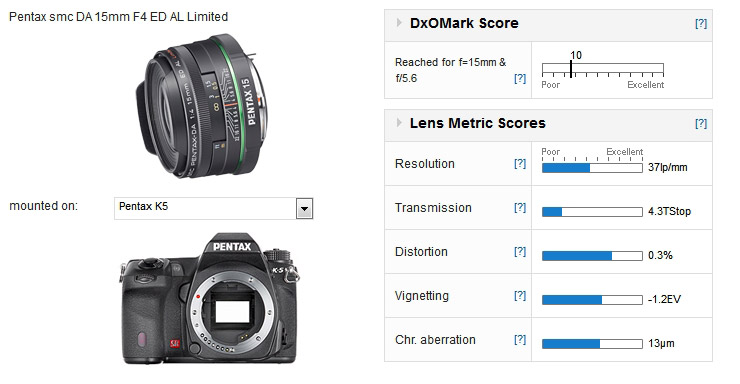
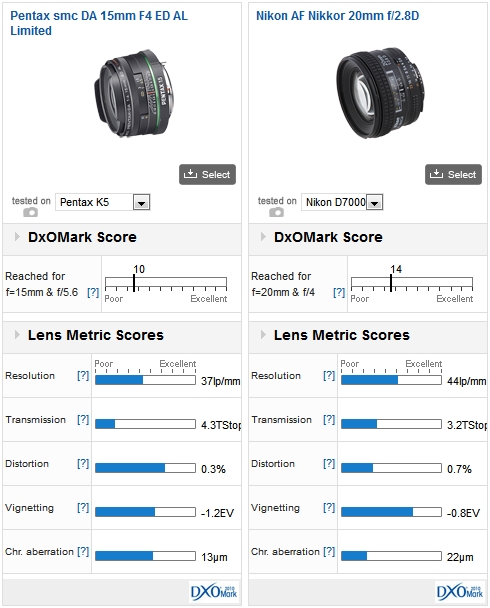
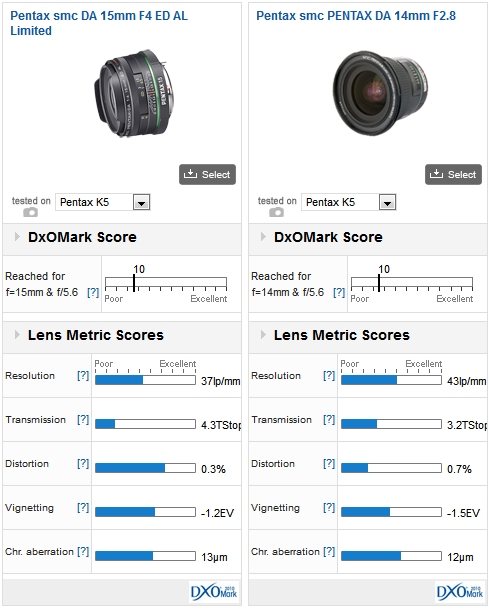
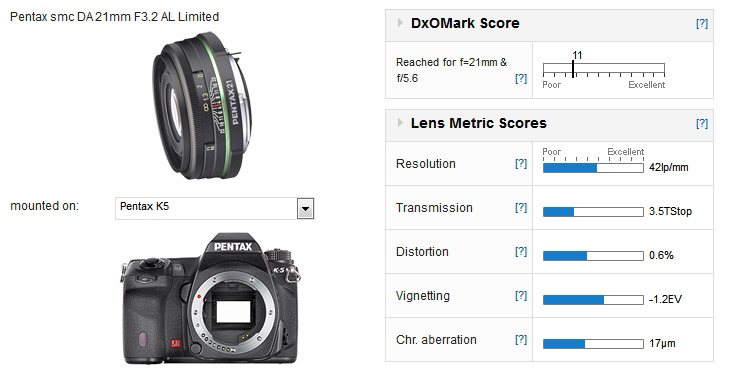
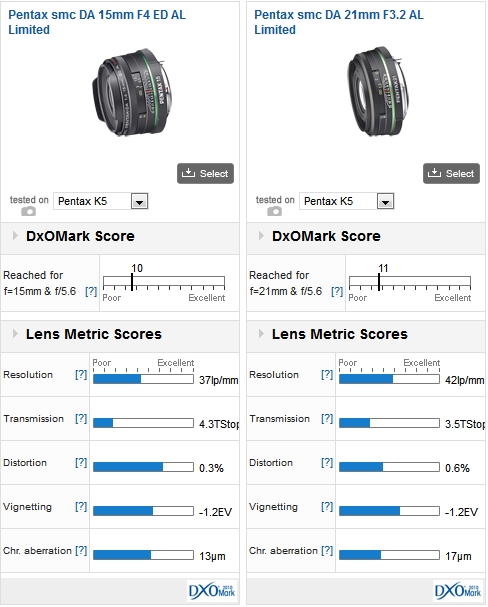
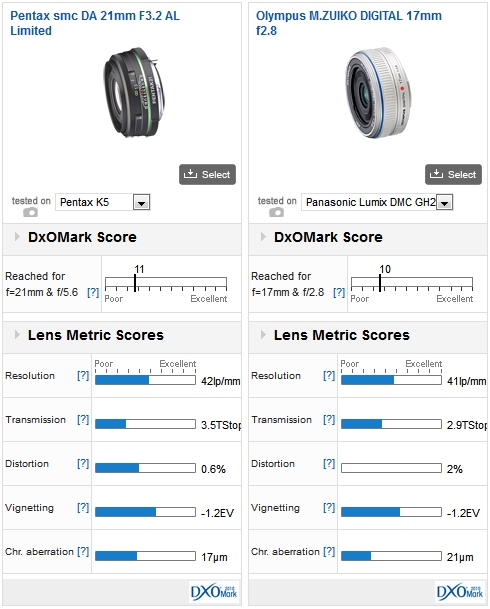
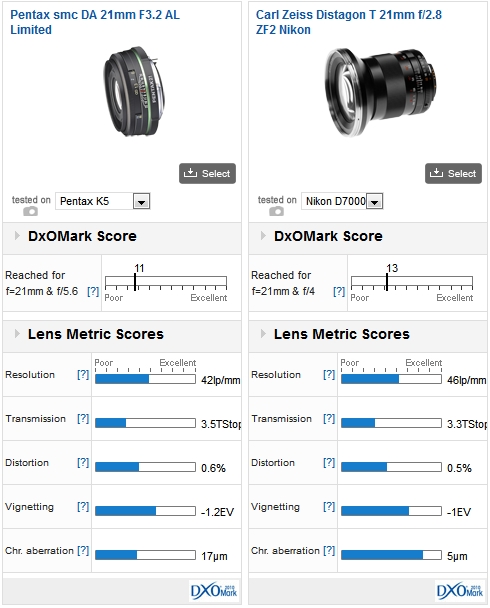
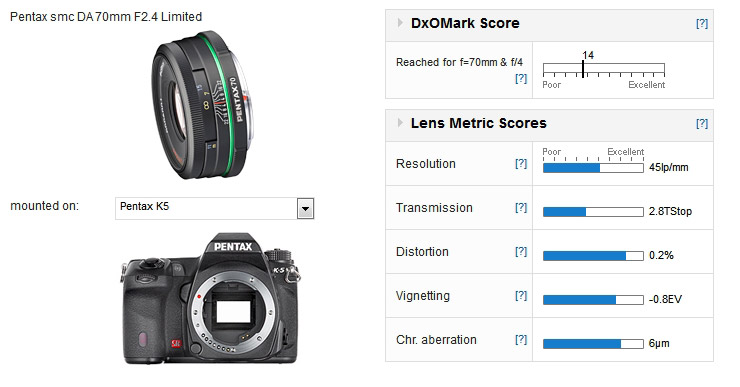
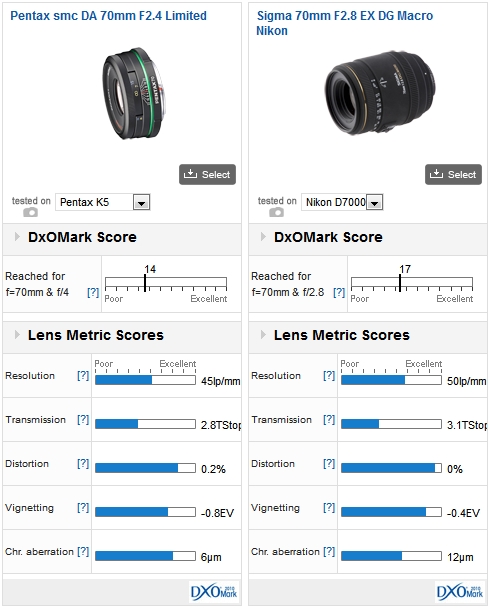
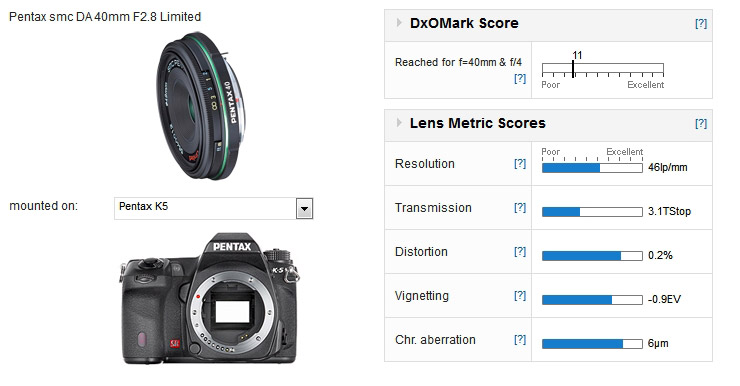
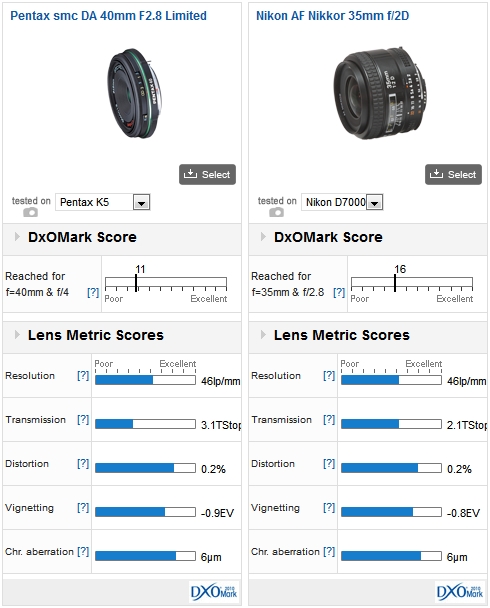
DXOMARK encourages its readers to share comments on the articles. To read or post comments, Disqus cookies are required. Change your Cookies Preferences and read more about our Comment Policy.